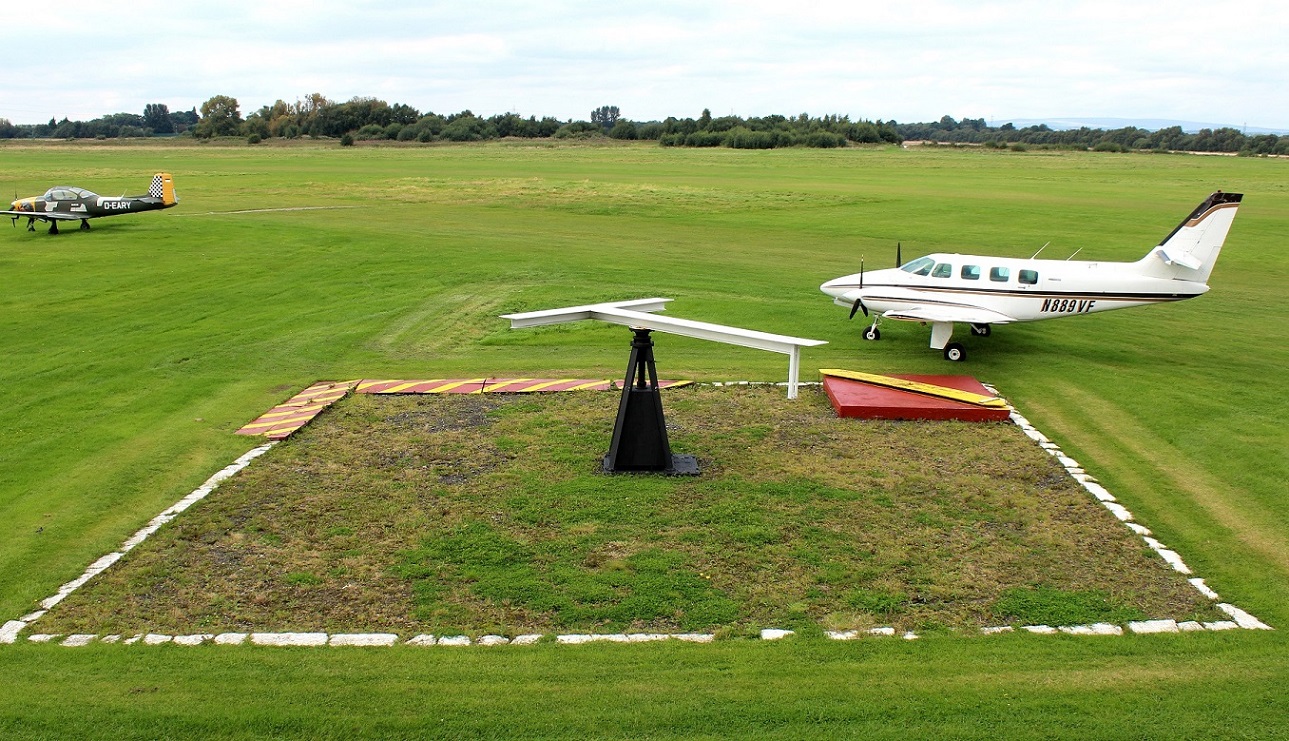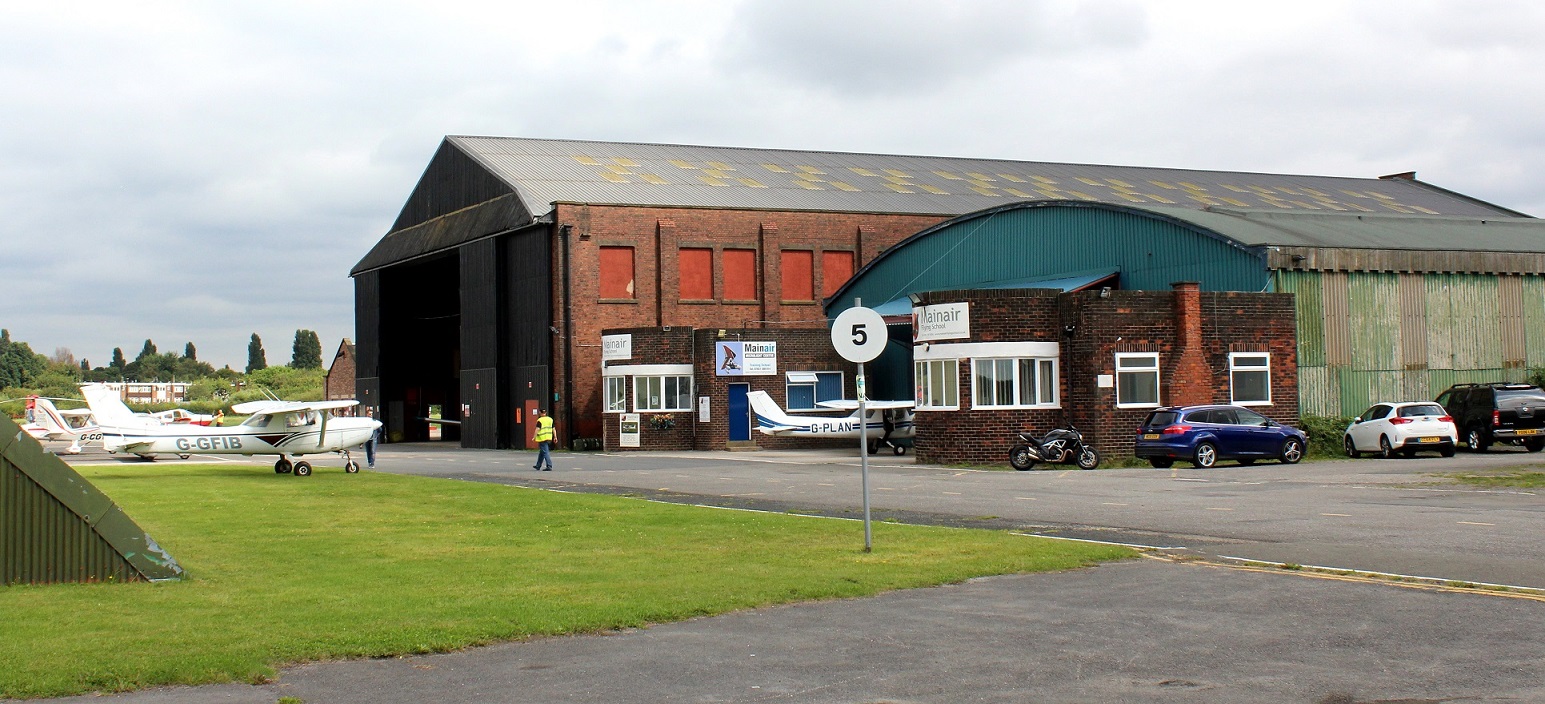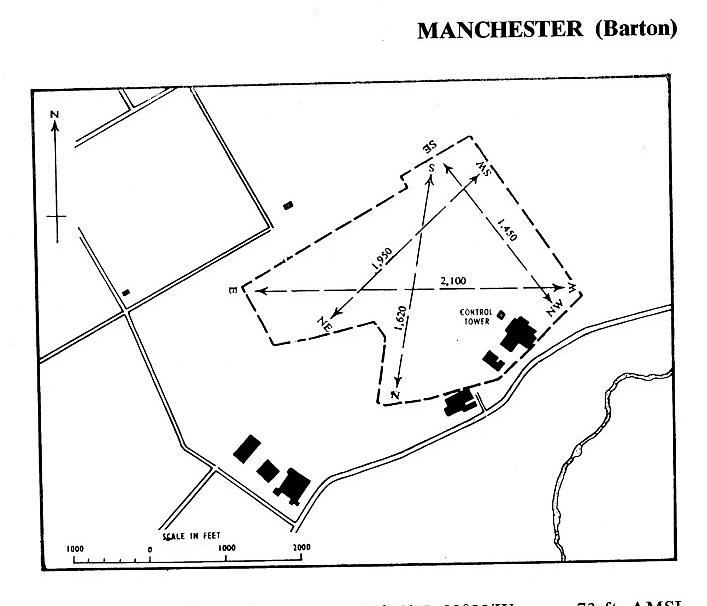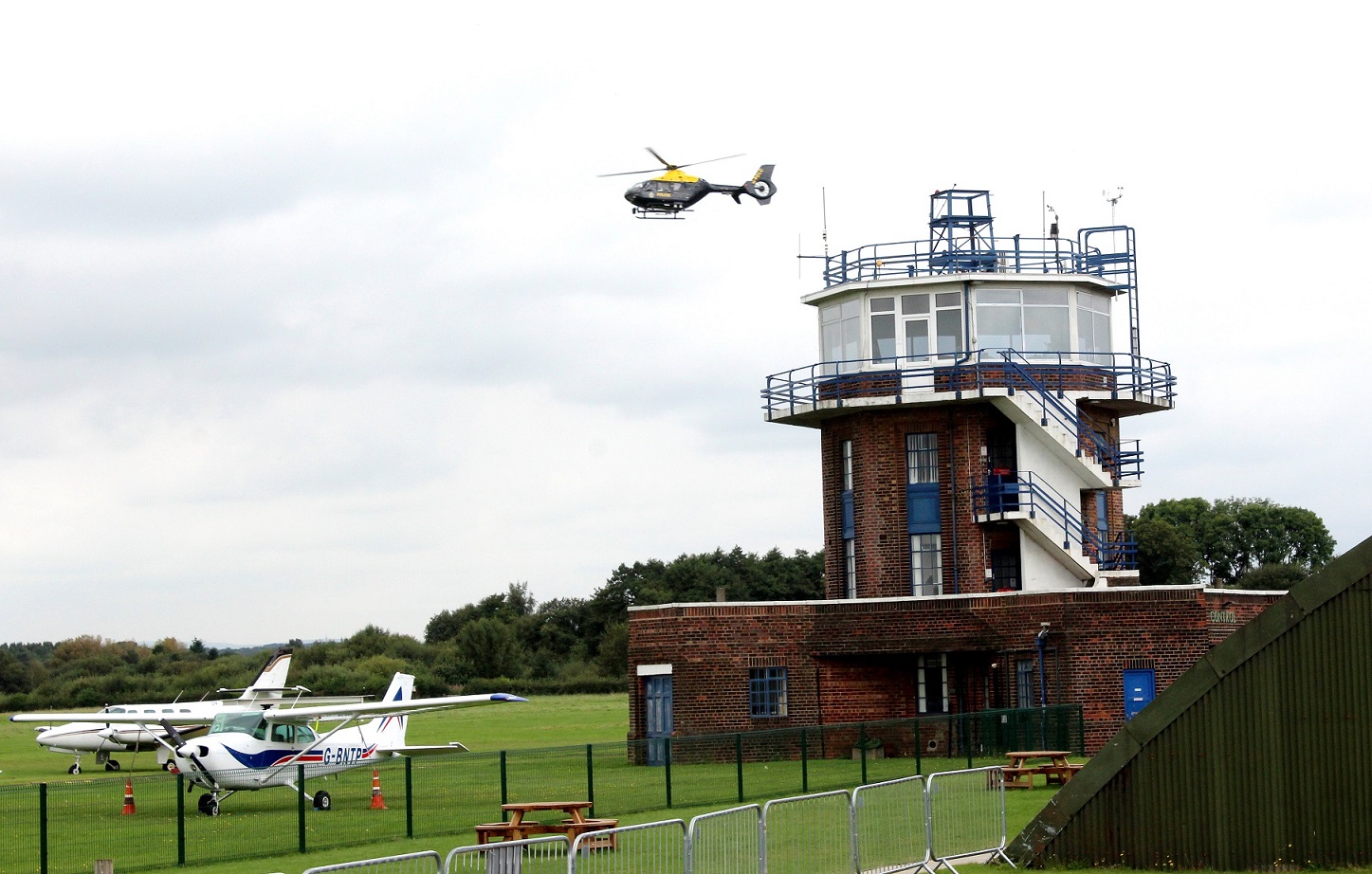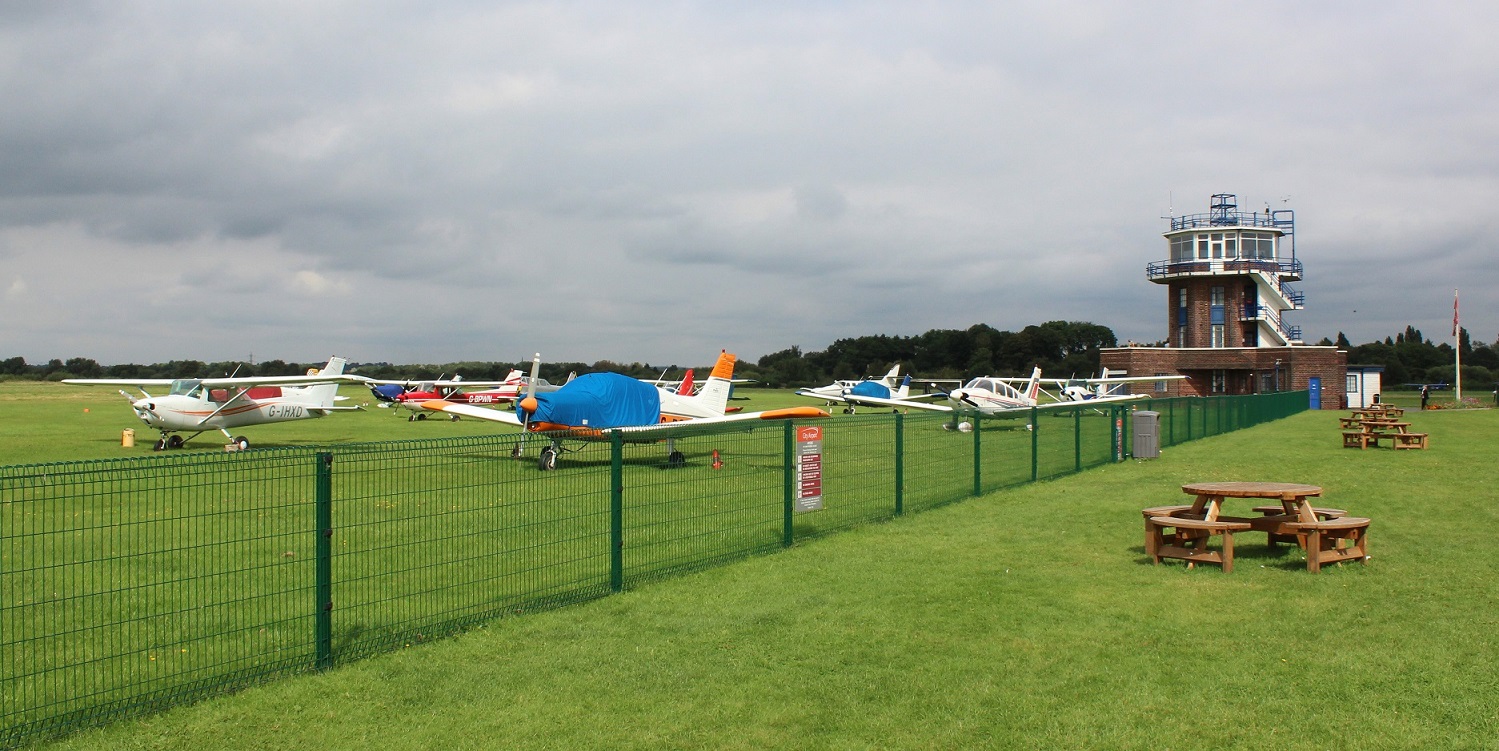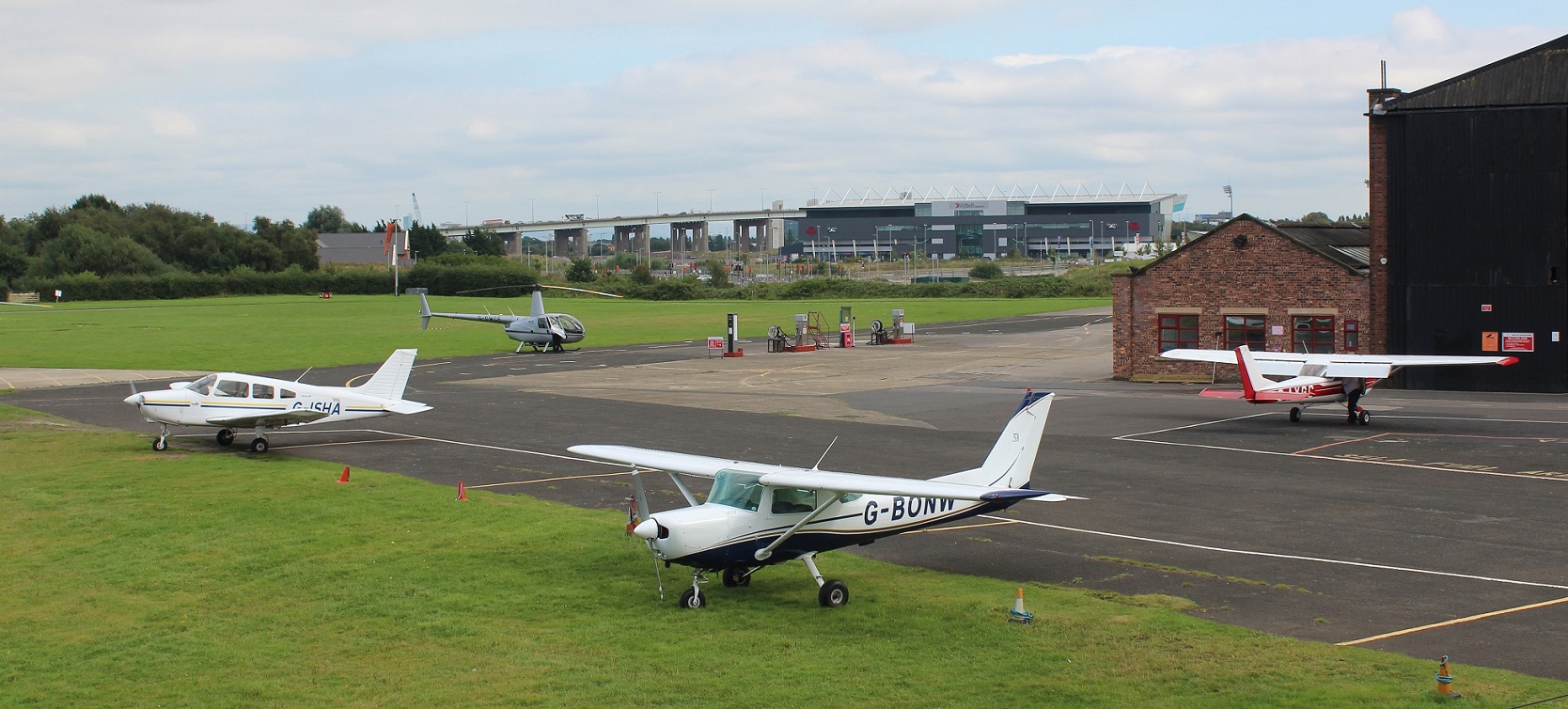Barton
BARTON: Civil regional airport later civil aerodrome
(Also known as AIR PORT of MANCHESTER in the 1930s, also EARLS BARTON. In 2008 also known as CITY AIRPORT MANCHESTER. Later known as CITY AIRPORT & HELIPORT)
BARTON was first commissioned as the principle civil municipal airport for Manchester.
The first picture was not dated but presumably it was taken not long after the aerodrome opened in 1925?
The second and fourth pictures are from postcards and kindly sent by Mike Charlton who has an amazing collection. See, www.aviationpostcard.co.uk
I image this aerial view (fourth picture) probably dates from the 1990s? If anybody can kindly offer advice, this will be most welcome.
Operated by: 1930s: Airwork on behalf of the Manchester Corporation
1965: Sivewright, Bacon & Co
1990/2000: Lancashire Aero Club
Military user: Pre 1940: 17 E&RFTS
British airline users: Pre 1940: Blackpool & West Coast Air Service, Hillman’s Airways, Imperial Airways**, Isle of Man Air Services, London, Scottish & Provincial Airways, Northern Air Lines (Manchester), Railway Air Services*
Charter/air taxi: Pre 1940: Northern Air Transport
Post 1945: Airviews, BCI Airways
Flying schools: Pre 1945: Lancashire Aero Club (1925)
Post 1945: Delta Aviation, Lancashire Aero Club, Manchester Advanced Flight Training (Barton)
Note: In the 1957 The Aeroplane directory, Lancashire Aero Club were listed as operating three Auster J/1 Autocrats, one Auster 5, one DH82A Tiger Moth and one Taylorcraft Plus D.
1959 ‘snapshot’: Bolton Flying Group, Brooklands Flying Group (also at RINGWAY), Lancashire Aero Club, Marwood Flying Group
Helicopter ops: The Manchester Helicopter Centre
Gyroplane school: Gyrocopter Experience
Maintenance: Post 1945: Air Taxi, Lancashire Aero Club, Light Planes (Lancashire)
Manufacturing: Pre 1940: The Fairey Aviation Co., F Hills & Sons
WW2: E Hills & Sons (More than 800 Percival Proctors)
Pleasure flights: Pre 1940: Northern Air Transport
Note: This picture from a postcard was kindly sent by Mike Charlton who has an amazing collection. See; www.aviationpostcard.co.uk
It is doubly interesting because, although the postcard is captioned "Berkshire Aviation Tours - Air Port Manchester" the Avro 504K G-ABHP (Ex J8371 in RAF service), was registered to Northern Air Transport from the 17th December 1930. It appears it was sold to Eire as EI-ANN in December 1932. However, it appears that Berkshire Aviation Tours amalgamated with Northern Air Transport in 1929. This said, other examples of out-of-date postcards being sold as souvenirs to passengers are quite common.
PICTURE GALLERY ONE
Note: All these pictures are by the author on a visit in August 2016.
Note: The smaller hangar in the foreground has a definite 1930s feel about it, certainly the offices on either side. Can anybody kindly date this?
Location: 5 nm W of Manchester
Period of operation: 1925 to present day (Became the official Manchester Municipal airport in 1930)
Runways: 1933: E/W 688 grass SE/NW 475 grass
Note: These maps reproduced by the kind permission of Pooleys Flight Equipment Ltd. Copyright Robert Pooley 2014.
1965: N/S 494 grass SE/NW 442 grass NE/SW 594 grass E/W 640 grass
1990: 02/20 530x33 grass 06/24 525x38 grass
09/27N 520x18 grass 09/27S 626x33 grass
14/32 410x33 grass
2000: 02/20 528x33 grass 09/27N 518x18 grass
09/27S 621x33 grass 14/32 396x33 grass
NOTES: The first municipal aerodrome/airport for Manchester was WYTHENSHAWE (CHESHIRE) which opened in April 1929 and quickly replaced by BARTON the following year. However, when the Manchester Corporation realised an even larger site was called for they opened a 250 acre airfield at RINGWAY (CHESHIRE), which grew into the present day MANCHESTER AIRPORT.
In June 1930 Northern Air Transport, (having taken over Berkshire Aviation Tours), set up base here with sixteen red and silver Avro 504Ks.
FLYING CIRCUS VENUE
The venue on the 29th May 1931 for the C.D. Barnard Air Tours ‘Tour of the UK’.
Venue on the 10th June 1932 for Alan Cobham’s National Aviation Day UK Display Tour.
On the 26th June 1933 for Cobham’s No.2 Tour of the UK. Likewise on the 28th and 29th July Cobham’s 1934 Tour displayed in/near Manchester. Was BARTON the venue?
PICTURE GALLERY TWO
Note: All pictures by the author on a visit in August 2016.
RAILWAY AIR SERVICES
On the 20th August 1934 Railway Air Services commenced a service using two DH.86s (G-ACPL and G-ACVY) from CROYDON via Birmingham (CASTLE BROMWICH) – Manchester – Belfast (ALDERGROVE?) to Glasgow (RENFREW). They also in that year started a freight and mail only service from BARTON using the DH.84 Dragon G-ACXL from BARTON to the Isle-of-Man (presumably RONALDSWAY) then onto Belfast (presumably ALDERGROVE).
*Railway Air Services might seem an odd choice of name for an airline? In The History of British European Airways Charles Woodley explains the origins of the airline. “In early 1930 Imperial Airways had become perturbed by the parliamentary powers that had been granted to the railway companies to operate cross-Channel air services. Approaches were made to the London Midland and Scottish Railway and the London and North Eastern Railway, which led to the eventual registration on 21 March 1934 of Railway Air Services Ltd.
One director was nominated by each of the constituent companies: the London Midland and Scottish Railway; the Great Western Railway; the London and North Eastern Railway; the Southern Railway; and Imperial Airways. The new company was based at the Imperial Airways terminus beside Victoria Station in London."
"Services commenced on 20 August 1934 over the route Glasgow (Renfrew) – Belfast (Aldergrove) – Manchester (Barton) – Birmingham (Castle Bromwich) – Croydon, using DH.86 biplanes. In the years leading up to World War Two, a varied fleet was operated, comprising DH.84 Dragon IIs, DH.86s, DH.89 Dragon Rapides, Avro XIXs and Douglas Dakotas.”
Douglas Dakotas? I feel 99% certain that Railway Air Services did not operate Douglas Dakotas prior to WW2. Indeed, the name Dakota was applied by the RAF to C-47 Skytrains being supplied under the Lend-Lease agreement which commenced in March 1941. Perhaps Mr Woodley became slightly confused as he shows a picture in his book, of G-AGZB in Railway Air Services colours, (it seems to have retained its wartime olive-green ‘camouflage’), at CROYDON.
A minor point to be sure, but it suitably introduces what Mr Woodley has to say next. “In October 1944 a plan was presented to the government by the Railway Company Association, under which Railway Air Services in a new form would operate post-war domestic and European air services, in partnership with other airlines and short-sea shipping interests to give complete interchangeability of tickets over their joint rail, sea and air networks.” Whow, what an incredibly far-sighted concept that was. Indeed, over 60 years later, the travelling public is still awaiting that kind of ease of travel arrangement! Wouldn’t it be wonderful to purchase a single ticket that gets you virtually door to door?
What he says next probably explains why it didn’t happen, and quite possibly, why it never will? “It would operate all its routes without government subsidy, provided that agreement could be reached between governments that no subsidies would be granted to competing European airlines.” I suppose the concept was far too simplistic? “However, the scheme was eventually rejected in favour of British European Airways.” This was an airline which went on to have a rather poor record in many aspecta of it’s operations; the exception being maintenance, which was reputed to be of a very high standard. Quite how this situation developed is beyond the scope of a simple 'Guide', but, it must be said that within BEA there had been some quite extraordinary individuals with immense imagination and flair.
**By 2013 I had become very sceptical about Imperial Airways ever having a service to Manchester (BARTON) and am now inclined to think this is attributed to some confusion regarding Railway Air Services, an airline which was operated by Imperial Airways.
Commercial airline operations ceased in 1938 when RINGWAY was opened.
PICTURE GALLERY THREE
Note: The Ikarus C42, designed and built in Germany, is arguably the best three-axis microlight type of recent times. It does, and can do, what "it says on the tin", and has set many records for this category of aircraft. Also, it is claimed, the hours flown by pilots flying the C42 exceed all other comparable types - a testimony to its excellent design and safe handling qualities. (Correct I believe up to 2016).
FAIREY AVIATION
Prior to WW2 the Fairey Aviation Co used BARTON for final assembly and test-flying of both the Hendon and Battle. It appears they took over the ‘Municipal’ hangar.
HILLSON
Compared to Avro and Fairey in this region the Hillson trading name of F Hills & Sons didn’t ring any bells for me when I started this research, but they obtained a license in 1936 to build the Czech Praga E.114 Air Baby which they called the Hillson Praga. The Praga engine was built by Jowett Cars and I’m old enough to remember seeing the rather odd looking Jowett Javelin car as a lad, which I suppose looking back, was actually quite a revolutionary design.
It certainly says something about the information network existing in those days because the first British Praga built at BARTON was exported to Australia – VH-UVP. They built 28 Pragas of which three were exported to Australia.
It appears the first aircraft F Hills & Sons built here was the Flying Flea G-ADOU in 1935. They also designed and built two aircraft with just one example of each. The first was the Hillson Pennine G-AFBX and the Hillson Helvellyn G-AFKT in 1940. Apart from building 812 Percival Proctors here in WW2 the company came up with the quite extraordinary ‘slip-wing’ concept whereby an expendable second wing to allow either increased all up weight and/or a shorter take-off run could be ejected in flight. See both BLACKPOOL and SEALAND for more details.
A REMARKABLE OCCURRENCE
In his excellent book Tiger Moth Stuart McKay tells us: “In December 1951, Gabrielle Patterson, a former ATA pilot of immense experience and skill, was engaged as Chief Flying Instructor with the Lancashire Aero Club at Barton. A lady flying instructor was so rare that the appointment made newspaper headlines.”
“Many of the larger clubs in the UK bid annually for contracts to train ATC cadets, and in some cases only the success of the application permitted the clubs to remain solvent.” This is from the caption to a picture which shows Ms Patterson standing beside the open cockpit and giving advice to an ATC cadet. Needless to say the aircraft in the picture is, of course – a Tiger Moth. Elsewhere in his book Mr McKay reminds us that after WW2 the venerable DH82 was used in a wide variety of ways: “So the solid dependable trainer became a workhorse: a crop-sprayer, glider tug, circus performer, aerobatic specialist, photographic mount, paradropper, tourer, seaplane, filmstar, recruiter, joyrider, racer, advertising gimmick, deck lander and museum exhibit. Nothing, it seems was, or indeed is, beyond the capabilities of the DH82; nothing that is, which might be considered to fall within the specification for and honest day’s work.”
Today it can be added that quite a few Tiger Moths have achieved the status of ‘prized possession’ and many of the owners have lavished so much care and attention on them that they can quite correctly also be regarded as pristine works of art. Of one thing I am quite certain, and that is that even when brand new from the factory – they were definitely not this good!
GOOD NEWS
Unlike so many UK airfields, on my visit in August 2016 I found the place buzzing and full of optimism. The future was it appears assured and considerable investment had been, and was still being, made. Such a refreshing change and so pleasing to witness.
A QUERY
In February 2021 I was contacted by Anne Lawson who had found a postcard and two photographs that belonged to her grandfather. Apparently both from the 6th September 1926 and at BARTON. She asked me if this could be possible? I thought it could indeed be possible?
The postcard is of the Avro 504K G-EBKR with Geoffrey Beck as pilot. This aircraft was registered to the Berkshire Aviation Company from December 1924 to August 1927 and Geoffrey Beck was one of their pilots. As the Berkshire Aviation Company was a touring operation it is quite likely that they visited BARTON before it became the Municipal Air Port for Manchester.
The Bristol F2B Fighter is another matter - such a shame the picture is rather fuzzy. But, Anne confirms it is D8096. I mention this because it was registered as G-AEPH on 13.11.36, so - is it just conceivable that it was already in private hands in 1926? This aircraft is of course still flying today with the Shuttleworth Collection. What we don't know is if the picture was taken at BARTON.
She tells us that her grandfather used to say he was "The Most Spectacular Spectator Of The Day", which could perhaps refer to a newspaper article? Possibly because he was taken on an aerobatic flight? If anybody can kindly shed more light on the above, this will be much appreciated.
A PERSONAL MEMORY
In November 2002 I was given the job of collecting the very rare Barker PE Stern ST80, G-BWVI, from the LONG MYND gliding site in SHROPSHIRE and delivering it to BARTON. The weather was truly awful in Manchester, but it has happy mermories for me. Such a privilege to move such a rare aeroplane.
Also, in the second picture the tail of the Raj Hamsa X-Air Jabiru G-CBDW can be seen inside my truck. This was one of the very few, and from memory possibly the only time, that I managed to combine two aircraft moves - with both aircraft transported together. This of course reduced the cost to both of the aircraft owners. The X-Air had been collected from DUNKESWELL (DEVON) and was delivered the next day to ESHOTT (NORTHUMBERLAND). Needless to say, this was only possible because both aircraft were on the small side.
We'd love to hear from you, so please scroll down to leave a comment!
Leave a comment ...
Copyright (c) UK Airfield Guide

























